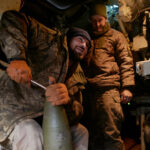The vast Shackleton impact crater near the south pole of the moon is an inhospitable place – its exposed rim is permanently bombarded by sunlight while the interior is permanently in shadow.
Temperatures can soar above boiling point on the surface and well below freezing in the darkness.
But the 21km (13-mile) -wide and 4km-deep feature may also harbour frozen water that could help support life on a lunar base – a possibility that has sparked the interest of the American and Chinese space programmes.
Space missions in both countries are reportedly preparing to land probes near the crater – the US later this year and China in 2026.
For now, the programmes are operating independently of each other but China and the United States should keep communication lines open for potential teamwork, US policy researchers said.
Both the Intuitive Machines 2 (IM-2), named after the US company that built it, and China’s Chang’e 7 probe will drill up to 1 metre (3.3 feet) below the surface near the Shackleton crater, and study extracted lunar samples. Each probe will also bring equipment called a “hopper” to scout permanently dark areas, including the crater floor, for traces of “water ice”.
The ice could be used to create oxygen and hydrogen, and then produce air, drinking water and fuel on the moon itself to sustain manned exploration, without the costly need to bring them all the way from Earth.
China’s moon missions, which began with the uncrewed lunar-orbiter Chang’e 1 in 2007, are aimed at building a basic lunar research station by 2028.

A Lunar Reconnaissance Orbiter wide-angle camera mosaic of the moon’s south pole. Photo: Nasa/GSFC/Arizona State University
While similar space missions normally offer a chance for countries to work together, the so-called Wolf Amendment – a law passed by the US Congress in 2011 – restricts Nasa from directly working with Chinese organisations over technology theft concerns.
During a 2024 financial year budget hearing before US lawmakers in April, Nasa chief Bill Nelson said the amendment should stay in force and underlined concerns about a “space race” with China.
“This is where we’re going and where China’s going [too] … My concern is if China were to get there first, they’d say ‘this is our territory; you stay out’,” Nelson said as he showed a picture of lunar landing sites to a US House appropriations subcommittee last month.
Roger Handberg, a political-science professor at the University of Central Florida, said some people viewed space “as the former US western frontier – you seize control because you can”. However, he was optimistic about future cooperation between China and the US.
“Nowadays everyone talks about the US and China as the leaders in lunar operations,” Handberg said. “The two will be major players in deciding the rules, which means the Wolf Amendment will go so that productive work can be done.”
“There is time to work out a solution that matches up to the original expectations in the Outer Space Treaty that space will not be a zone for conflict, but for cooperative activities generally,” Handberg said, referring to the 1967 treaty for the peaceful exploration and use of space, signed by more than 110 countries as of March.
While finding water ice on the moon would give an edge, he said it could be a decade before either China or the US developed the ability to retrieve and process it.
Daytime temperatures on the lunar surface can reach a boiling 120 degrees Celsius (248 degrees Fahrenheit), but remote sensing data has shown a significant amount of ice deposited in the permanently shadowed interior of some lunar craters.
One such well-studied crater is the bowl-shaped Shackleton, named after Antarctic explorer Ernest Shackleton and sitting almost exactly at the lunar south pole. The south pole is defined by both the US and China as an area within 5 to 6 degrees latitude of the lunar south pole.
Few places on the moon come with the conditions needed for sustainable human exploration, such as continual sunlight to power vehicles and lunar bases. But while it is always dark at the bottom of the Shackleton crater, parts of its rim are permanently in sunlight.
In 2021, Nasa and IM announced that the Texas-based company would develop a commercial lunar lander to deliver an ice drill to an area known as the Shackleton connecting ridge, just west of the crater.
“This area receives sufficient sunlight to power a lander for a 10-day mission, while also providing a clear line of sight to Earth for constant communications,” Nasa said.
It was referring to the IM-2 mission, which is scheduled to lift off in November at the earliest.
China has yet to officially announce the landing site for its Chang’e 7 mission, but according to Wu Yanhua, chief designer of the country’s Deep Space Exploration programme, its top candidate is also the Shackleton crater region.
Chang’e 7 would aim for an area southeast of Shackleton, Wu told the First International Deep Space Exploration Conference, or Tiandu Forum, in the Chinese city of Hefei last month.
Papers published in Chinese-language journals have already shown China’s strong interest in going to the crater. Shackleton was ranked first in a 2020 analysis of suitable zones and spots for lunar south pole landing, as Chang’e 4 mission commander Zhang He and her colleagues reported in the Journal of Deep Space Exploration in June that year.
While the moon’s south pole is of high value to scientists and future human explorers alike because of water ice, its surface full of craters poses a major challenge for robotic and crewed landing. “It’s a dangerous place to land, and there are few precious parts where you can do it,” Nelson told House appropriators last month.
In August, Nasa announced the selection of 13 potential landing zones for its Artemis III mission. Planned for after 2025, the mission will mark the first return of humans to the moon in half a century, and will be the first time astronauts explore the lunar south pole.
Researchers in China have also identified a number of preferred landing areas in the south pole, with a few such as the Shackleton and Haworth craters overlapping with Nasa’s choices. China also hopes to send astronauts to the moon by 2030.
However, even with overlapping landing locations, mission conflict is unlikely – since each location is over 100 sq km (38 square mils) in size and contains multiple landing spots.
The US and China are now assembling their own moon camps under the framework of the Artemis Accords and the International Lunar Research Station, respectively.
“While major space players will lead a particular settlement – one way to think of them is city states – they should interact in order to survive collectively as the lunar environment is harsh and unforgiving,” Handberg said.
“The process of space exploration is difficult, complicated and expensive. Even the two powers may find the burden heavy, and the need for cooperative activities will become more obvious that the Wolf Amendment goes away.”
Brian Weeden from the Secure World Foundation, a Washington-based think tank, also urged the US government to revise the amendment and resume bilateral exchanges with China, as he gave testimony before the US-China Economic Security Review Commission earlier this month.
“Congress should modify the Wolf Amendment to allow Nasa to engage in space activities with China that support US national interests,” Weeden said, citing priority engagement areas such as basic space science, robotic space exploration and increased data sharing on space weather and orbital debris.
China was conducting or planning to conduct many of the same space activities as the US, so the two nations did have areas where their interests aligned, Weeden said. Meanwhile, China had been constructive in its interactions with the international community on space law and norms, he told the commission.
Handberg said there was already some nibbling away at the restrictions on a more informal level, which would increase over time. However, the amendment would not be overturned until there was a real need to do so, he said.
“Over time, the amendment is effectively nullified through exceptions, even though the title may remain.”
Source : SCMP
















Add Comment